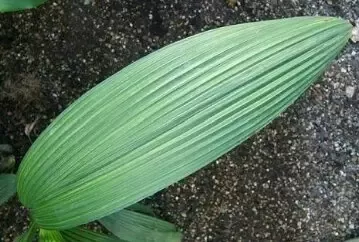
Answer
477k+ views
Hint: Parallel venation is generally observed in monocot plants whereas the dicot plants will form reticulate venation. In plants with parallel venation, the veins will never meet.
Complete answer:
Veins are a part of the vascular tissue that is present throughout the plant. The organization/design of the veins in the leaves are called venation.Venation plays a crucial role in differentiating different plants based on their characters. It is important for providing mechanical support, growth, and coordination among various parts of plants.The two types of venation are parallel venation and reticulate venation. As grass is monocot it shows parallel venation.

Fig.A. Leaf representing parallel venation

Fig.B. Leaf representing Reticulate venation
Additional Information:
Parallel venation: The arrangement of veins parallelly to each other is called parallel venation. In parallel venation, the veins will certainly not join to other veins. Also, branching will not be observed in plants having parallel venation.
Monocot plants form parallel venation. The mid-vein characteristics will classify parallel venation into pinnate parallel venation and palmate parallel venation.
Pinnate parallel venation: It possesses a central mid-rib from which numerous veins will arise in a perpendicular direction and will be parallel to each other.
Palmate parallel venation: The veins rise from the petiole and will run parallelly to each other. These veins will join on the apex. Palmate parallel venation is further classified into convergent and divergent parallel venation.
The veins of the grass rise from the laminal base of the leaf and will converge at its apex. Hence it is called convergent parallel venation.
So, the correct answer is ‘grass’.
Note: The other type of leaf venation is reticulate venation in which the veins look like a web. Monocot plants like grass, bamboo, wheat, banana, maize form parallel venation. On the contrary, Calophyllum, a dicot plant shows parallel venation and Smilax species, a monocot plant forms reticulate venation.
Complete answer:
Veins are a part of the vascular tissue that is present throughout the plant. The organization/design of the veins in the leaves are called venation.Venation plays a crucial role in differentiating different plants based on their characters. It is important for providing mechanical support, growth, and coordination among various parts of plants.The two types of venation are parallel venation and reticulate venation. As grass is monocot it shows parallel venation.

Fig.A. Leaf representing parallel venation

Fig.B. Leaf representing Reticulate venation
Additional Information:
Parallel venation: The arrangement of veins parallelly to each other is called parallel venation. In parallel venation, the veins will certainly not join to other veins. Also, branching will not be observed in plants having parallel venation.
Monocot plants form parallel venation. The mid-vein characteristics will classify parallel venation into pinnate parallel venation and palmate parallel venation.
Pinnate parallel venation: It possesses a central mid-rib from which numerous veins will arise in a perpendicular direction and will be parallel to each other.
Palmate parallel venation: The veins rise from the petiole and will run parallelly to each other. These veins will join on the apex. Palmate parallel venation is further classified into convergent and divergent parallel venation.
The veins of the grass rise from the laminal base of the leaf and will converge at its apex. Hence it is called convergent parallel venation.
So, the correct answer is ‘grass’.
Note: The other type of leaf venation is reticulate venation in which the veins look like a web. Monocot plants like grass, bamboo, wheat, banana, maize form parallel venation. On the contrary, Calophyllum, a dicot plant shows parallel venation and Smilax species, a monocot plant forms reticulate venation.
Recently Updated Pages
Fill in the blanks with suitable prepositions Break class 10 english CBSE

Fill in the blanks with suitable articles Tribune is class 10 english CBSE

Rearrange the following words and phrases to form a class 10 english CBSE

Select the opposite of the given word Permit aGive class 10 english CBSE

Fill in the blank with the most appropriate option class 10 english CBSE

Some places have oneline notices Which option is a class 10 english CBSE

Trending doubts
Fill the blanks with the suitable prepositions 1 The class 9 english CBSE

How do you graph the function fx 4x class 9 maths CBSE

Which are the Top 10 Largest Countries of the World?

What is the definite integral of zero a constant b class 12 maths CBSE

The Equation xxx + 2 is Satisfied when x is Equal to Class 10 Maths

Differentiate between homogeneous and heterogeneous class 12 chemistry CBSE

Define the term system surroundings open system closed class 11 chemistry CBSE

Full Form of IASDMIPSIFSIRSPOLICE class 7 social science CBSE

Change the following sentences into negative and interrogative class 10 english CBSE




